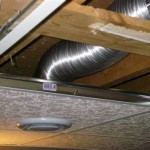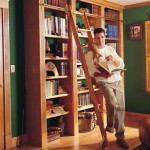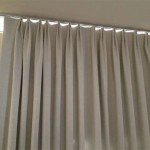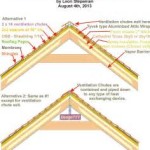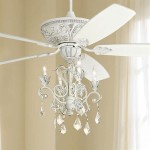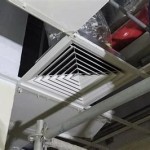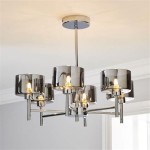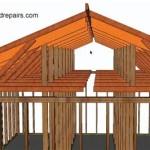How To Hang A Ceiling Fan On A Slanted Ceiling
Installing a ceiling fan on a slanted ceiling presents unique challenges compared to a standard, flat ceiling installation. The angle requires specific hardware and techniques to ensure the fan hangs correctly, operates safely, and doesn't wobble. This article provides a detailed guide covering the necessary preparations, steps, and considerations for successfully hanging a ceiling fan on a slanted or sloped ceiling. It assumes a basic understanding of electrical wiring and safe working practices. If you lack this experience, it is highly recommended to consult a qualified electrician.
Before starting the installation process, carefully assess the ceiling slope and available support structure. This assessment will determine the type of mounting hardware required and influence the installation procedure. Failing to properly evaluate these factors can result in an unstable or improperly functioning ceiling fan.
Key Point 1: Preparing for the Installation
Preparation is critical for a successful ceiling fan installation, especially on a slanted ceiling. This stage involves gathering the necessary tools and materials, understanding the fan's specifications, and ensuring electrical safety.
First, assemble all the required tools. These typically include: a stud finder, measuring tape, level, electrical tape or wire connectors, a screwdriver set (both Phillips head and flathead), wire stripper, pliers, drill with appropriate drill bits, safety glasses, work gloves, and a ladder suitable for reaching the ceiling. A voltage tester is crucial for confirming that the electrical circuit is de-energized before working on the wiring.
Next, gather the necessary materials. These include the ceiling fan itself, which ideally should be rated for sloped ceilings. A downrod appropriate for the ceiling angle is essential. This is a longer rod than typically provided with a standard fan, allowing the fan blades to clear the ceiling at their lowest point. Ensure the downrod is compatible with the fan model. A specialized mounting bracket designed for slanted ceilings is also required. These brackets often feature an adjustable ball-and-socket joint that allows the downrod to hang vertically even on an angled surface. Wire connectors (wire nuts) are needed to make secure electrical connections. Grounding wire is essential to ensure the fan is properly grounded.
Prior to commencing any electrical work, the power to the circuit must be switched off at the circuit breaker. Confirm the power is off using a voltage tester. This step is paramount for preventing electrical shock. Double-checking the absence of voltage is strongly advised.
Carefully unpack the ceiling fan and verify that all components are present based on the manufacturer's instructions. Read the instruction manual thoroughly. Understand the wiring diagram and assembly instructions specific to your fan model. Pay close attention to any warnings or cautions provided by the manufacturer.
Identify the ceiling joist or structural member that will support the fan. A stud finder can help locate these. The fan must be securely mounted to a structural member capable of handling its weight and the dynamic forces it generates during operation. If no suitable joist is available, a fan-rated ceiling brace may need to be installed between existing joists. This brace provides a solid mounting point for the fan bracket.
Determine the angle of the ceiling slope using a level and measuring tape or a protractor. This measurement is crucial for selecting the correct downrod length and ensuring the mounting bracket is properly aligned. Most specialized mounting brackets are designed to accommodate specific ranges of ceiling slopes, so confirming compatibility is essential.
Key Point 2: Installation Process
With the preparation completed, the actual installation can commence. This stage involves installing the mounting bracket, wiring the fan, and attaching the fan motor and blades.
Begin by installing the slanted ceiling mounting bracket. Position the bracket over the identified ceiling joist or fan-rated brace. Ensure the bracket is oriented correctly according to the manufacturer's instructions, considering the ceiling slope and the desired direction of the fan. Secure the bracket to the joist using lag screws or other appropriate fasteners. The bracket must be firmly attached to provide a stable base for the fan.
Next, prepare the electrical wiring. Identify the wires extending from the ceiling (typically black for hot, white for neutral, and green or bare copper for ground). Strip the ends of these wires and connect them to the corresponding wires from the mounting bracket or wiring harness according to the fan’s wiring diagram. Use wire connectors (wire nuts) to make secure connections, ensuring no bare wire is exposed. Wrap the wire connectors with electrical tape for added safety and insulation. The grounding wire is particularly important; ensure it is properly connected to the grounding screw or terminal on the mounting bracket.
Carefully lift the fan motor assembly and attach it to the mounting bracket. This typically involves inserting the downrod through the bracket's swivel ball or socket. Secure the downrod to the motor assembly according to the manufacturer's instructions, using screws or pins. Ensure the downrod is properly locked into place to prevent the fan from detaching during operation.
Connect the fan motor's electrical wires to the corresponding wires in the ceiling's wiring harness. Again, use wire connectors to make secure connections and ensure proper insulation. Tuck all wires neatly into the mounting bracket's housing to prevent them from interfering with the fan's operation or causing a hazard.
Attach the fan blades to the motor assembly. Follow the manufacturer's instructions carefully, as the blade orientation and attachment method can vary depending on the fan model. Ensure all blades are securely fastened and properly balanced to prevent wobbling. Some fans may include balancing kits to fine-tune the blade balance after installation.
Install any light fixtures or other accessories that are included with the fan. Follow the manufacturer's instructions for wiring and attaching these components. Ensure all connections are secure and properly insulated.
Key Point 3: Testing and Final Adjustments
After completing the installation, thorough testing is essential to ensure the fan operates correctly and safely. This stage involves verifying the wiring, checking the fan's operation at different speeds, and making any necessary adjustments to balance the blades.
Restore power to the circuit at the circuit breaker. Carefully observe the fan as it starts. Check for any unusual noises, vibrations, or sparks. If any issues are detected, immediately turn off the power and re-examine the wiring and connections.
Test the fan at all speed settings. Ensure the fan motor operates smoothly and quietly at each speed. Verify that the fan blades rotate in the correct direction (typically counterclockwise for summer cooling and clockwise for winter heat circulation). If the fan rotates in the wrong direction, locate the reverse switch (usually on the fan motor housing) and flip it to change the direction.
Observe the fan for any signs of wobbling. A slight wobble is often normal, but excessive wobbling can be caused by unbalanced blades, loose connections, or an improperly installed mounting bracket. If wobbling is excessive, try the following:
Tighten all screws and fasteners on the fan blades, motor housing, and mounting bracket.
Use the balancing kit provided with the fan to adjust the blade balance. This typically involves attaching small weights to the blades to counteract any imbalance.
Check the alignment of the fan blades. Ensure they are all at the same height and angle. Minor adjustments may be necessary to achieve proper balance.
If the wobbling persists despite these efforts, consider consulting a professional electrician or ceiling fan installer. There may be an underlying issue with the installation or fan itself that requires expert attention.
Finally, thoroughly clean the area around the fan and dispose of any packing materials or debris. Ensure all tools and equipment are stored safely.
By following these steps carefully and paying attention to detail, you can successfully install a ceiling fan on a slanted ceiling and enjoy its benefits for years to come.

How To Install A Ceiling Fan On Sloped Lemon Thistle

How To Choose A Ceiling Fan For Vaulted Ceilings Lightology

How To Install A Ceiling Fan On Sloped Lemon Thistle

Vaulted Sloped Ceiling Adapter For Modern Fan Company Fans Stardust

Ensuring Proper Ceiling Fan Installation With Vaulted Ceilings

How To Find Ceiling Fans Slope Adapters And Downrods For Angled Ceilings Delmarfans Com

How To Choose A Ceiling Fan For Vaulted Ceilings Lightology

Fans On An Angle Installing Ceiling Angled Or Raked

How To Install A Ceiling Fan On Sloped Lemon Thistle

Vaulted Sloped Ceiling Adapter For Modern Fan Company Fans Stardust
Related Posts

